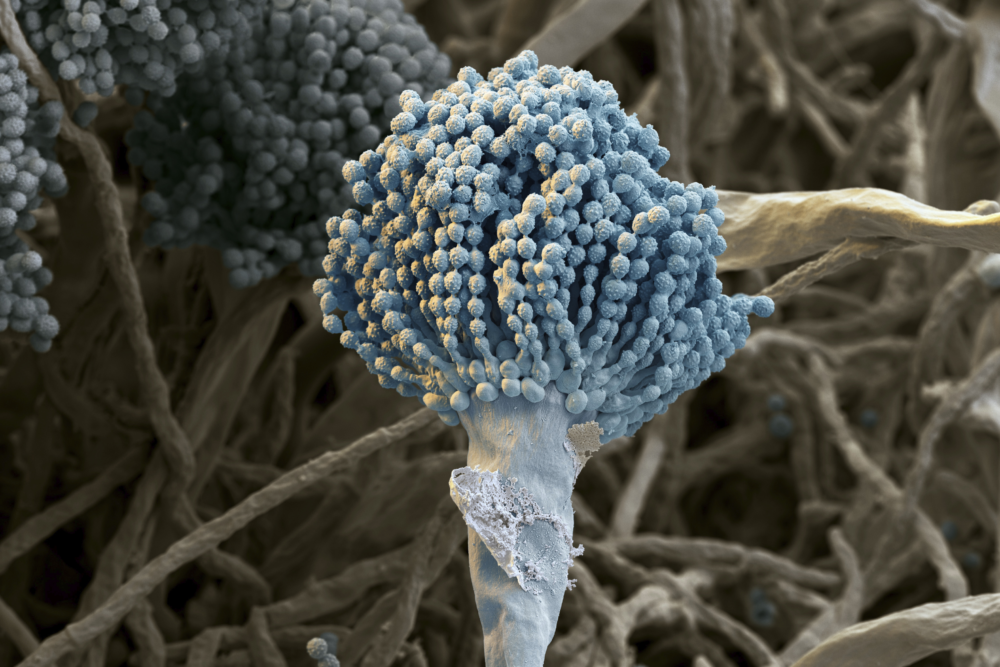A new global study has revealed that climate change is reshaping the habitats of deadly fungi, including the Aspergillus species, which can infect humans, animals, and crops. As temperatures rise and weather patterns shift, these fungi are expected to spread into new regions, putting health and food systems at risk.
🦠 What is Aspergillus?

Aspergillus is a group of fungi commonly found in soil, air, plants, and even homes. It plays an important environmental role by breaking down dead organic matter. However, some types of Aspergillus can cause serious infections in humans and animals, and spoil crops through toxin contamination.
We breathe in hundreds of Aspergillus spores every day. These spores are tiny and float in the air, entering our lungs easily. For healthy people, the immune system clears them out. But for those who are ill, elderly, or have weak immunity, these spores can lead to dangerous conditions such as:
-
Invasive aspergillosis (IA) – a potentially fatal lung and bloodstream infection
-
Chronic pulmonary aspergillosis (CPA) – a long-lasting lung disease
-
Allergic reactions – in sensitive individuals
These fungi also cause crop damage and food poisoning, especially from toxins like aflatoxins found in maize, peanuts, and rice.
🔬 The Study: Where the Fungi Live Today—and Where They’re Headed
Scientists analyzed soil and climate data from around the world and used computer models to track three major disease-causing Aspergillus species:
-
A. fumigatus – causes most human infections
-
A. flavus – produces deadly aflatoxins, infects crops and humans
-
A. niger – spoils food and causes illness in both humans and plants

They used a tool called MaxEnt modeling to predict where these fungi live now and how climate change will affect their spread up to the year 2100, using three scenarios: mild (SSP126), moderate (SSP245), and severe warming (SSP585).
📈 What Did They Find?
-
A. fumigatus prefers cooler climates (like Europe, China, and the U.S.).
-
A. flavus and A. niger thrive in warmer, tropical regions (Africa, South Asia, Brazil).
As the climate warms:
-
All three fungi will move northward, especially under severe climate scenarios.
-
New regions in Russia, China, Europe, and even Alaska may become suitable for these fungi.
-
Tropical and southern regions may lose suitable habitats, especially for A. flavus.
🌾 What About Crops?

The study looked at how these fungi interact with major global crops like maize, rice, wheat, grapes, and apples.

-
A. flavus is expected to lose much of its habitat in crop-growing areas, especially in Africa and South America, by 2100.
-
A. niger will remain widespread, especially in the Northern Hemisphere.
-
Crops in India, China, and the U.S. may continue to be at risk.
For example, A. flavus currently overlaps with 19.1 million km² of maize farmland. That could drop to just 6.8 million km² by 2090, making aflatoxin outbreaks less likely in some places, but more likely in others.
🧬 Human Health Risks: Still Alarming

Right now, an estimated:
-
1.98 billion people live in areas where A. fumigatus thrives
-
905 million in A. niger zones
-
846 million in A. flavus zones
By 2100, those numbers could drop by up to 60–70%, but in regions like northern Europe, Australia, and parts of the U.S., risk could actually rise.
The study also found a strong connection between where Aspergillus fungi are in the environment and where people are infected with them in hospitals.
“Where the fungus lives, it spreads — and people nearby are at greater risk of getting sick.”
Aspergillus infections already cause:
-
2.1 million cases of invasive aspergillosis globally per year
-
Over 340,000 deaths from chronic infections
-
Billions in losses due to crop contamination and spoilage
On top of this, drug resistance is rising, because the same chemicals used on crops are also used to treat patients—making the fungus harder to kill.
✅ What Needs to Happen?
This research shows that:
-
Surveillance systems must track how fungal threats are shifting due to climate change
-
Agricultural and medical policies need to avoid overuse of antifungal chemicals
-
Public health planning must account for these emerging fungal risks in warming regions
“This is not just about mushrooms in the forest,” the authors said.
“It’s about what we breathe, what we eat, and where our food grows. Climate change is changing all of that.”
(Inputs- Research Square)








